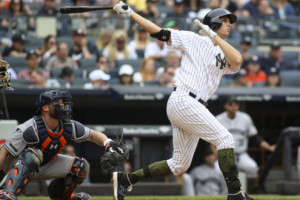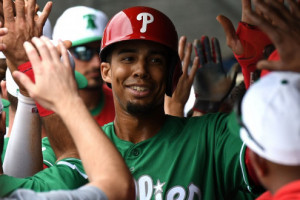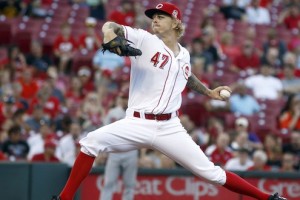Are You Not Entertained?

Are you not entertained? Is this not why you are here?
Typically, one of the draws of my weekly article – for most readers – is the fact that this article is enjoyable to read, even if it’s not always super in-depth or particularly even “helpful” from an analytical, numbers-based standpoint. Sure, we’ve had some weeks this year in which we took some time to dig deeply into numbers (which were not the most popular articles I’ve written this year, but they were certainly helpful). Generally, however, I save the deeper numbers-digging for my RotoAcademy courses and my MLB Edge articles on Tuesdays and Fridays.
This week? You guessed it – we’re going to do things a bit differently. This week, we’re going to dig into some numbers – looking at two specific things you can use to gain an edge over the last five weeks of the season.
The first thing we will be exploring is the ways in which you can take full advantage of the influx of NFL players during the final few weeks of baseball.
The second thing we will be exploring is the ways in which you can take full advantage of the influx of Minor League players (many of whom will be making spot starts down the stretch) once rosters expand in September.
Now, I’ll be honest: my initial motivation in taking this approach with this particular article was the fact that I leave on Tuesday morning for a six-week trip to Thailand (for those wondering: the purpose of the trip is… well, is “Why the heck not?” as my wife and I can both work from anywhere, and we don’t have kids, so we have a little place on the beach where we’ll be staying for six weeks – kicking it in Phuket and working from over there; so if you enjoy my articles, don’t worry, you’ll still get your regular dose – and if you hate my articles, do worry, because you’ll still get your regular dose). As fun as that sounds, it means that my last few days, before we leave, are among the busiest days I can ever remember having, as I try to wrap up all my NFL RotoAcademy courses, write all my RotoGrinders articles, wrap up a few other freelance projects, pack, make sure I’m all set for the trip, etc. (as I type this on Friday evening, I project myself to have 56 hours of work remaining in the next 80 hours – not including non-work stuff I have to do; looks like I won’t be getting much sleep!).
I say all that to say: I figured digging into thoughts such as these would be less time-consuming than doing a bunch of writing. But I was wrong (uh – yeah, Jordan – you think?). Digging into all this has taken more time than writing a normal article.
Oh well.
Maybe it’s a lose-lose. Maybe I lose by taking even more time than normal to write this article, and maybe you lose because I’m not going out of my way to be entertaining or engaging. Or, maybe it’s a lose-win; I lose because this is taking me more time, but you win because you get some interesting information that is likely to help you over these last five weeks of the season!
TAKING ADVANTAGE OF THE INFLUX OF NEW MLB DFS PLAYERS
In case you are wondering: No, the influx of new players to MLB DFS is not particularly dramatic (not like the influx of players into NBA when NFL season first ends – as people have spent months absorbed in NFL, and they suddenly feel a big hole in their DFS Heart that they look to NBA to fill). At the start of NFL season, we’ll get a massive number of new players moving into the DFS realm. Because these new players will just be learning DFS, however, there won’t be a huge percentage that decides, within those first few weeks of the season, that they want to find a way to play DFS every single day.
But with that said: there certainly are players who make that decision! Last September, I introduced probably 12 to 15 friends to DFS during the start of NFL season. At least three of those friends were playing MLB for the last few weeks of the MLB regular season.
So, no, there isn’t a massive influx of new players. No, they aren’t around for a super long time. But they are there – and they don’t know what they are doing.
Here, then, is my advice to you – in three parts:
1) Pay attention to the softness of the field
As soon as NFL starts, you should start paying attention to the field in both double-ups and tournaments. Study rosters now, and study rosters then. Are you seeing more rosters with “what the heck” plays on them? Are you seeing more throwaway entries in double-ups and tournaments? Are you starting to see lineups that lead you to ask, “Does this person even know what they are doing?”
When the MLB season begins, we always have an influx of new players who have migrated over from season-long fantasy baseball or from daily fantasy basketball. As the season progresses, the truly bad players tend to drop out, and the good players tend to stick around; as such, it often becomes more and more difficult to cash in MLB as we get deeper into the season. Once you start seeing these softer rosters, however, it means that a big edge has been reintroduced to MLB DFS. If you are seeing rosters that cause you to ask, “Does this person even know what they are doing?” it’s probably not a practical joke. The person, probably, does not know what they are doing.
2) Play things safe in cash games!
Once you start seeing these “WTF” lineups, it means you will have an edge in cash games, as there will be a larger-than-normal percentage of the field that is putting in dead entries. Essentially, these dead entries can offset the rake (and maybe even go a little beyond that) – which pretty much makes cash games the equivalent of “cash games with overlay.”
As such, your goal in cash games should be playing things safely. As we get deeper into the season, we reach a point where the playing field becomes fairly level, and you either need a really sharp night or one or two slightly riskier plays (that pay off) in order to consistently cash in cash games. As the field softens, however, this “need for a great night” somewhat disappears.
Make the smart plays! – and enjoy the edge that is already built into the field.
3) Play in a few more tourneys than normal
We all like to end a DFS season on a high note, and as such, it can be tempting to call it a season after “one last big win” down the stretch. While this feels comfortable, however, my advice to you is this: take a few more shots at tournaments than you would normally take.
While some of those who migrate over from NFL will jump into cash games, a much larger percentage of people making the move to MLB are seeking the thrill they had on Sunday, when they “had a chance to win lots of money all at once.” This means that these people will be entering tournaments (and not just low-dollar tourneys, either, as some of these individuals will have enjoyed a big weekend in NFL and will feel that money burning a hole in their pockets when “it could be making even more money in MLB tournaments!”). This means that, rather than sitting back and enjoying your winnings (or enjoying what you salvaged as a result of that last solid day!), you should recognize that – as is the case with cash games – most tournaments will almost play like there is a decent chunk of overlay. Because the percentage of dead money in these tourneys will be larger than the percentage of dead money in cash games, the “overlay” will be greater as well. This means that it can be a +EV strategy to increase your tourney play over those last few weeks.
Of course, it’s still tournaments, and variance still comes into play. And – as we all know – some of these “dead entries” will walk into a huge DFS score and a nice cash. But all in all, these tourneys will start to play as though there is a decent chunk of overlay. Over time, this is hugely +EV for you as a seasoned player, so it makes sense to try to take advantage of this edge while it is there.
TAKING ADVANTAGE OF THE INFLUX OF NEW, REAL-LIFE MLB PLAYERS
One of the things we should always be looking for in DFS is players who should be priced far higher than they are actually priced. The time we see this most often in NFL or NBA is when a starter gets hurt and the backup will be taking over – often stepping into the same role. In MLB, however, things are a bit more complicated, as these “great values” often come from Minor League players who have been called up to the Majors. Because we have less data on these players, it is more difficult to follow our normal process in predicting how they are likely to do. With a bit of extra digging, however, we can determine whether or not a Minor Leaguer is a solid play – rather than simply “guessing” or “fading” as the mood strikes us. When rosters expand in September and these younger players start getting spot starts, being able to evaluate them before their prices spike will be a valuable weapon to have.
In order to show you the sorts of things I look for, I am going to take a look at a pair of real-life examples at hitter from this last week, along with a real-life example at pitcher from this last week. All of these are guys I rostered, and here was my thinking with each:

Greg Bird: Of course, most of us rostered Bird in cash games the day of his second start – when he hit a pair of home runs on a small slate – but far fewer rostered him the night before, when he still put up a solid game. The reason I rostered him that night? I started by looking at Bird’s Baseball Reference page – looking at his Minor League numbers for 2015 and scrolling down past his game logs to find his splits (caution: a lot of information is forthcoming; bookmark this article if you need to, and reference it as you do this yourself in September, as I am pretty much giving you a step-by-step look at what I do). This is what I saw: against right-handed pitching this year, Bird has a .287 batting average and an excellent .390 on base percentage (this shows a good eye and patience at the plate – and also shows a high floor for us in rostering him), and a very strong .865 OPS. This tells us already that he’s a solid play. Taking things one step further, however, I also like to calculate a hitter’s strikeout rate, by taking his strikeouts and dividing these by his total plate appearances. For Bird, we see (on the day I’m typing this) 45 strikeouts against right-handed pitching, in 288 plate appearances. This gives us a strikeout rate of 15.6%. Considering league average is around 20%, this is a very strong number – telling us that Bird not only has a good eye, but he also makes lots of contact. Finally, we need to look at power numbers to see what we’re getting. In 288 plate appearances against righties, he notched 11 home runs – which is a home run every 26 at bats. Since most Major League hitters get a little over 600 plate appearances per season, this enables us to look at Bird as a guy who has “25 home run” power. Obviously, some of this is rudimentary, but we are not trying to create a perfect prediction model; we are simply trying to get a feel for the type of hitter a guy is, and whether or not he is worth rostering at minimum (or near-minimum) price. Taking a low-strikeout, high-OBP, solid-power lefty at Yankee Stadium in a soft matchup – at minimum price – falls squarely in the category of “no brainer”!

Aaron Altherr: Altherr has flown WAY under the radar so far compared to Bird, but he’s been almost as strong of a play. Altherr is an outfielder for the Phillies whom they seem to be set on only using against left-handed pitching. That’s fine with us, though as Altherr’s numbers this year in 132 plate appearances against lefties have him at a .324 batting average, a .432 OBP, and a 1.034 OPS! He has struck out against lefties this year at a mere 12.1% rate, and he is launching one home run per every 26 plate appearances – again, putting him in the same category as Bird. These are the kinds of players who can provide you with a sizable edge when you roster them at a cheap price. (Update to this article on Saturday night: today, I rostered Altherr in DraftKings cash games for the second time in his last two starts. He cost $3100 and hit a 9th inning home run – after a fly out in the second, another fly out in the 5th on what would have been a double if not for a slick play by Ichiro, and a sharp line out in the 7th that also would have been a double if Prado hadn’t snagged it. Although he is clearly hitting the ball well, and although he notched a double, a walk, and two runs scored in his previous start on Thursday, he was only 2% owned in cash games. This is the sort of edge that shows up when these players make their debuts! Some of them, like Bird, get all the attention and see high ownership, but others are like Altherr and go completely unnoticed as they put up solid game after solid game.)

John Lamb: Lamb was one of the pitchers who moved from the Royals to the Reds in the Johnny Cueto deal. While we don’t normally like picking on the Diamondbacks with left-handed pitchers, Lamb was far too cheap to ignore the other day, and he made his way onto my main tournament lineup. With pitchers, I start at Fangraphs, where you can quickly see their overall strikeout rate and walk rate. In Lamb, we saw a pitcher who has clearly changed his approach on the mound this year, as his strikeout rate jumped from 21.3% last year to 25.1% this year, and his walk rate dropped drastically as well. From here, we move to Baseball Reference (again, looking at the player’s Minor League page and scrolling down past their game logs on their 2015 page). By dividing his strikeouts against each handedness by the total plate appearances against each handedness (for example: by dividing the 93 strikeouts he has against righties by the 364 plate appearances against righties), we find he has a 25.5% strikeout rate against righties and a 27.7% strikeout rate against lefties. Those are elite numbers – and while they will not translate fully to the Majors, we went into that start knowing we could get a high-strikeout guy (one who can strike out both lefties and righties) at a very cheap price. Finally, I’ll glance at the game logs and look at the ground balls (“GB”) and fly balls (“FB”) allowed. From scrolling through, I could see that Lamb allows far more fly balls than ground balls; this means he’s at higher risk of giving up home runs, but is at a lower risk of giving up lots of hits. At his price point, it was fairly easy to take the plunge in tournaments.
Over the last five weeks of the season, we will start to find that there is more of an edge available than there was for the last couple months. Understand where this edge can be found – and be ready to take full advantage of it when it comes!
So, there you go. You’re not entertained – but sometimes, that isn’t really such a bad thing at all.